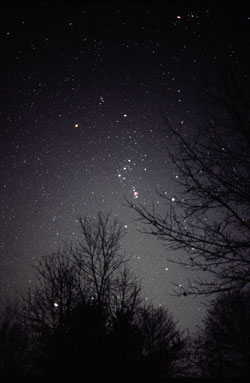How can I find out how our Sun would look among the constellations, as seen from a nearby star? What made me curious was a painting by space artist David Hardy that pictured the Sun as an extra star in Cassiopeia.

S&T: Dennis di Cicco
Fancy planetarium projectors produce such scenes, but you can easily get a good idea from a back-of-the-envelope calculation. Let’s say you are going to Barnard’s Star, which is 5.94 light-years away at right ascension 17h 57.8m, declination +4° 42'. The Sun will appear directly opposite it on the sky, so subtract 12h from the right ascension (or add 12h, as the case may be), and change the sign of the declination. That puts the Sun at 5h 57.8m, –4° 42', in the constellation Orion as seen from Barnard’s Star. All of Orion’s other bright stars are hundreds of light-years away, so the constellation remains much the same as we see it — except for a new 1.1-magnitude star right off the Belt!
Similarly, Proxima Centauri lies at 14h 29.8m, –62° 41', and its opposite point is in eastern Cassiopeia. As viewed from Proxima’s distance of 4.22 light-years, the Sun would appear magnitude +0.4, outshining all other stars in Cassiopeia and adding another “zig” to the zig-zag star pattern.
When you plot the distant Sun on a star chart, keep in mind that a few stars in the immediate solar neighborhood will shift inward toward the Sun and become slightly dimmer because they are being viewed from farther back.
— Roger W. Sinnott
 0
0








Comments
You must be logged in to post a comment.